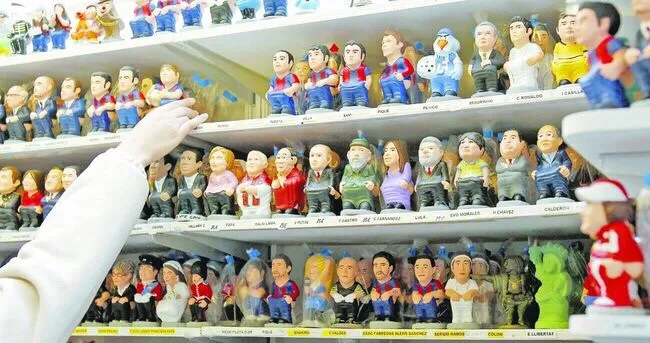
How About a Cagener for your Nativity Scene?
If you’re shopping for a Nativity scene in a market in Barcelona, Spain, they have everything you need. Joseph and Mary? Check. Baby Jesus? Check. Donkeys, sheep and cows? Check. Defecating world leaders? Check.
A few years ago a friend told me about what is perhaps the strangest Christmas tradition imaginable among the Catalans — those with roots in the northern Spanish community of Catalonia. Hidden in the Catalan Christmas creche, often a broader pastoral scene of the city of Bethlehem, is a little porcelain Caganer (the most polite translation is “the Defecator”), with trousers down, defecating in a secluded spot behind a rock or a tree, away from the manger, of course. Children play the game of hunting for the hidden Caganer. Traditionally, he is a peasant wearing a red hat, white shirt and his pants are half down.
In the spirit of crass Christmas commercialism, however, you can now purchase tiny clay statues of celebrities in the Caganerian squatting position. Rock stars and royalty. The Pope. Spiderman. Even Sponge Bob.
The Caganer has been offering his unique presents to the Nativity scene for at least two centuries, although in recent years the Catalan government has banned him from official displays.
No one knows the origin of this impish custom. One explanation is that he is fertilizing the land for a good harvest the next year. The Caganer may remind us of that we are all equal, at least in certain private acts. It might be just irreverent humour.
The notion that makes most sense to me is that the Caganer is a reminder of the reality into which Christians believe God comes. Face it, have you ever been in a stable or a barn? If the smell doesn’t drive you out, the flies might. And watch where you’re stepping!
There are no carols about the flies buzzing around Joseph’s head. So canticles about the Christmas manure. No poems about the noise and confusion. The tale of a birth in a barn has morphed into a clean, tinsel-shiny, potpourri-scented season of the year. It is our natural inclination to whitewash reality.
We are not the first generation to be offended by reality. In the year 1635, Queen Anne of Austria gave these instructions to her royal architect: “The church must be a sumptuous and magnificent sanctuary, in order to compensate as much as possible for the extreme vulgarity and poverty of the place where the Eternal Word chose to be born.”
The story of Christmas is that Jesus was born, but not in a plastic stable lit by red and green floodlights on the church lawn. The word of God did not become flesh in an ornate baroque or rococo cathedral, but immersed in the grunge and grime of a cowshed somewhere in Palestine.
The faces the Holy Child would have seen first, after Mary and Joseph, would have been animals, not necessarily bowing in humble adoration. but doing what animals do — staring into space, bothering each other, chewing their food and being rather odious. But we have sanitized the stable because, well, reality is often harsh and repulsive. We retreat from reality into our imaginations. In the real world, women are browbeaten by devout men and children die from hunger because adults steal relief food.
So we have choreographed and cleaned up the Nativity. But a healthy and even humorous dose of reality at Christmas can be redemptive, putting us in our rightful place — not perched at the pristine centre, but squatting among the animals, doing what all animals do.
Post a comment